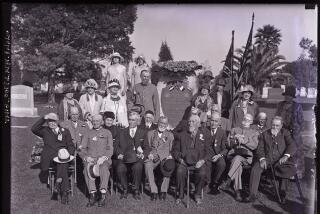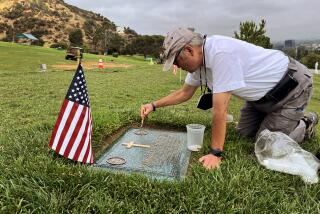World War Iâs Sgt. York : Neglected American Hero to Get a Monument in France
PALL MALL, Tenn. â In France, they have kept his memory. The villagers of Chatel-Chehery even named the nearby knoll where he did his extraordinary deed Mont York.
To todayâs generation of Americans, though, the name Alvin Cullum York--Sgt. York--a name that to their parents and grandparents was one of the most celebrated in the land, is all but forgotten.
So, on Memorial Day, a group from Tennessee, the place of Yorkâs birth 100 years ago, will gather at the Chatel-Chehery village hall and raise a modest monument there to the memory of their native son, who died, still a hero, in 1964.
Eight thousand people attended his funeral then. All but about 100 of them stood in a pasture outside the small church he had built in Pall Mall when he returned from the war.
âWar to End All Warsâ
âI think it is appropriate that the monument be in France,â said one of Yorkâs sons, Andrew Jackson York, who is 57. Andrew will represent the York family at the ceremony. âThose were the people who were liberated. Besides, Iâve never been there. Iâve heard about what he did all my life, and Iâm anxious to see where it all happened.â
What Sgt. York did, on Oct. 8, 1918, in the last stages of âthe war to end all wars,â is recorded tersely on a bronze plaque, in French and English, set in the monumentâs black granite base.
âArmed with his rifle and pistol, his courage and skill,â it reads in part, âhe silenced a German battalion of 35 machine guns, killed 25 enemy soldiers and captured 132.â
It also quotes Marshal Ferdinand Foch when he awarded York the French Croix de Guerre to go with his American Medal of Honor and a chestful of other decorations:
âWhat you did was the greatest thing accomplished by any private soldier of all the armies of Europe.â
âHere at home,â Andrew York recalled recently, standing on the porch of the York home place in Pall Mall, âwe could never get Daddy to talk about what he did. He said it was something heâd rather forget.
His Duty
âBut he would tell visitors about it because he thought it was his duty, since they came all this way out of their way to meet him.
âSo what I know is what I overheard, and, of course, what I read and saw in the movie. My mother said the movie was accurate--except for the part about the lightning hitting his rifle. She said that didnât happen. But she didnât object because it was Hollywoodâs way of saying his conversion was sudden, which it was.â
For three decades, the Sgt. York story was the stuff of countless newspaper and magazine articles and of a 1941 Oscar-winning movie starring Gary Cooper. Hollywood could scarcely ignore these ingredients: Sharpshooting, backwoods, Bible-toting, pacifist church elder and reluctant draftee becomes American legend in Argonne Forest, the greatest battle the U.S. Army had ever fought.
And, yes, people who visited Pall Mall, Tenn., to shake the legendâs hand did have to go out of their way.
America does not have many places more rural than Fentress County, deep in the Cumberland Mountains of northern Tennessee on the Kentucky border, or more remote than Pall Mall.
When Alvin York took a leave home from basic training to struggle with his conscience over whether to fight or not to fight, he had to walk the last 12 miles because there was no road to Pall Mall. There is now. It is a two-lane extension of State Road 127, now named the Alvin C. York Highway.
It still is the only paved road in Pall Mall. It goes past the York homestead, now padlocked, and the post office, which provides one of two non-farming activities in town. The other is the Alvin York gristmill, where Andrew York worked until it was closed in 1958 because of his fatherâs poor health. Andrew, the areaâs forest ranger, lives on a hill nearby. The mill now attracts a dwindling number of aging tourists who examine it unsupervised and sign its guest book.
It is a sturdy old structure of pine siding and timbers hewn from oak. It stands on a bend in the valley of the Three Forks of the Wolf, a green and peaceful place. Wood ducks provide the only sound other than the waterfall and the millrace.
The valley attracted Alvin Yorkâs pioneering forebears in the 1790s. It was not always peaceful. Alvin, born in a one-room log cabin, the third of 11 children of the village smithy, grew up hearing tales of blood feuds and killings and of hatreds spawned by the Civil War, which had ended only 23 years before his birth.
âAll thatâs left of the cabin is that rock chimney,â said his son, pointing. Andrew can also point out the three remaining chimneys of his motherâs birthplace on the adjacent farm. She was one of 15 children. Her familyâs log house was 150 years old when it burned 11 years ago. The barn is still in use.
Alvinâs father died when he was a boy. While growing up, Alvin earned a reputation as a hard worker in the family blacksmith shop but also as one of the valleyâs most accomplished drinkers and brawlers--and marksmen.
At weekly shooting matches, a social highlight among the mountain men, the prizes for the six events were six portions of a beef. More than once, Alvin York won all six and walked the steer home on a rope.
âDaddy taught all of us to shoot,â said his son. Indeed, ranger Andrew Yorkâs two qualifying pistol scores at the Police Academy were 299 out of 300 and 300 out of 300. âThey expected it of me,â he said
Alvin Yorkâs life changed dramatically when he was 27, a change that contributed as much as his feat of arms to the enormous popularity of the war hero.
Joined Church
On Jan. 1, 1915--he noted the date carefully--to the great relief of his widowed mother, Alvin joined a fundamentalist church and took the Bible to heart, literally.
His conversion was less the result of a lightning flash of truth than the ultimatum of his comely next-door neighbor, Gracie Williams. She told Alvin she would not even think of marrying him unless he mended his ways.
âHe became an untarnished hero at a time when the country needed a hero,â said Russell Hippe, the chairman of Tennesseeâs Historical Commission. Hippe, a Nashville lawyer, is a student of Yorkâs life and times. He made the arrangements for the Memorial Day ceremony in France and will attend it.
âAlvin York,â he said, âregistered as a conscientious objector, was offered non-combat duty and changed his mind about fighting only after he decided it was Godâs will.
âThat went a long way toward convincing many Americans that a complex and terrifying war was a righteous cause.
Victory of Man
âHe also,â Hippe continued, âexemplified the victory of a man over a monster. Here was a single human, an uneducated mountaineer to boot, taking on, alone, a whole battalion of machine guns, the deadliest product of the confusing machine age. York became more than a hero. He became a symbol.â
His behavior of the hero after the war further elevated him in Americaâs esteem. He turned down promotional offers that would have netted him at least $500,000 at a time of a farm recession.
Instead, he returned to Pall Mall, married Gracie and lived as simply as his celebrity would allow, blacksmithing, raising hogs and grinding his neighborsâ corn.
He did accept a piece of bottomland and a farmhouse. It was bought with money raised by the Rotary Club, which raised the $8,500 for the Chatel-Chehery monument also.
The house was finished in 1922, and there Gracie bore all their eight children: Alvin Jr.; George E. Buxton, named for Alvinâs commanding officer; Woodrow Wilson; Sam Houston; Andrew Jackson; Betsy Ross; Mary Alice, named for both her grandmothers, and Thomas Jefferson. Two others died at birth. Five survive: George, Woodrow, Andrew, Betsy and Mary.
The house has been padlocked since Gracie Yorkâs death in 1984, but Andrew opened it recently to show a visitor.
He pointed out his fatherâs Medal of Honor citation hanging in the foyer. The document, though framed, is badly stained.
âA toilet overflowed upstairs, and water leaked all over it,â Andrew explained. âDaddy didnât seem to mind.â
More to Read
Sign up for Essential California
The most important California stories and recommendations in your inbox every morning.
You may occasionally receive promotional content from the Los Angeles Times.










